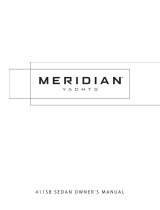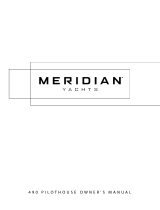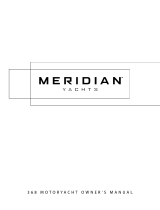
••••••••••••••••••••••••••••••••••••••••••••••••••••••
v1.0
37 - Propulsion System
Viking Sport Cruiser 61FY
Owner’s Manual
Engine loses revs underway
If engines surge at high revs, but not when you slow down,
the problem is likely fuel related.
•Is there plenty of fuel in the tank(s)?
•Are the remote fuel valve handles
FULLY down?
•Is a Separ filter clogged? Switch the
selector lever to the other in the pair,
or to the center position for maximum flow.
•Is correct filter element in place? It is possible a me-
chanic mistakenly installed a 2 micron filter in the Separ
filter instead of the specified 30 micron type. If so, it
will quickly become clogged and not pass through
enough fuel at high revs.
•Other possibilities:- The Separ filters may need
backflushing (see Separ manual). The MAN secondary
fine fuel filter may be clogged. You may have got poor
fuel at the last fill up.
Both engines stop while underway
This is an unlikely occurrence and should be easy to
troubleshoot. If the Rexroth alarm did not sound, and the
fans are still running, the likely cause is a fault in the Sea-
Fire system – an electrical connection may have corroded,
or come loose. Check connections at Sea-Fire relay box S
behind the Salon helm (access is via the removeable panel
in the stb cabin headliner).
A loose or broken connection in the two-wire circuit C from
the engine room fire bottle to the Sea-Fire relays will likely
cause a Sea-Fire shutdown of BOTH engines, but with no
accompanying alarm state. If the problem is intermittent,
caused by vibration, the engines will simply start again nor-
mally, but the problem will recur.
If, when the engines stopped, the green CHARGE light re-
mained on, this is a good indication of a false alarm – a
real alarm would certainly discharge one of the bottles
and the red DISCHARGE light would be on.
Even with an apparent “false” alarm, ensure there is no
smoke or fire in the engine room, or the lazarette. If there
is neither, switch the Sea-Fire alarm to the OVERRIDE posi-
tion R. This will bypass the shutdown relays until the prob-
lem can be resolved.
There is a difference between the engine room and laza-
rette fire bottles:- either can activate a Sea-Fire alarm,
but only the engine room bottle precipitates shutdown of
engines and blowers.
Sea-Fire relay box
Glass phial breaks
if discharged
remote activator
Override Fully charged
Separ filter selector
If selector handle is in this position only ONE filter is in
use. At sustained high revs fuel flow may be insufficient.
Move handle to center position to draw from both filters.
IN USE SPARE
Sea-Fire status and override
It is safe to switch to OVERRIDE if:
•THERE IS NO FIRE,
•the red discharge light is NOT lit,
•the bottle gauge B is on green (fully charged).
Under override the engines should restart and keep
on running. However, OVERRIDE defeats the ignition
safety system and the fault must be corrected as soon
as you reach a marina.
B
S
C
➟
➟
R

















